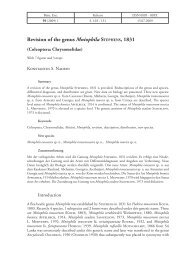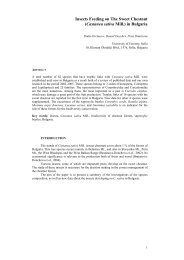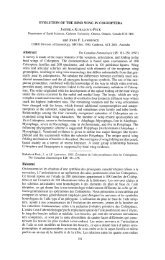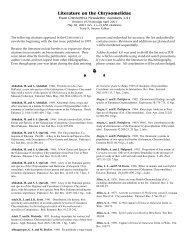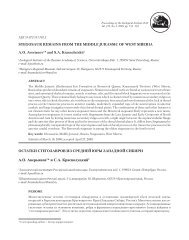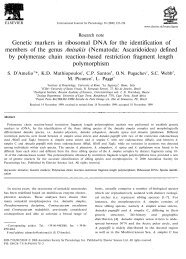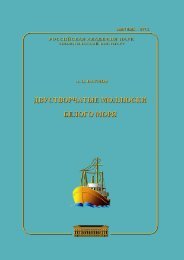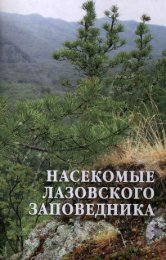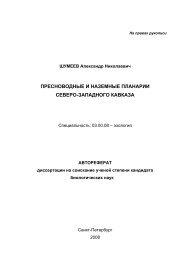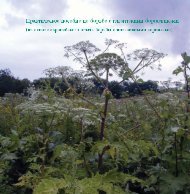latvian molytinae (coleoptera, curculionidae) - Daugavpils ...
latvian molytinae (coleoptera, curculionidae) - Daugavpils ...
latvian molytinae (coleoptera, curculionidae) - Daugavpils ...
- No tags were found...
You also want an ePaper? Increase the reach of your titles
YUMPU automatically turns print PDFs into web optimized ePapers that Google loves.
Balalaikins M., Bukejs A.In the review of the Kurzeme (Curland) fauna(Groschke 1805), a list of the pested beetles ispresented, where Hylobius abietis (Linnaeus,1758) and Pissodes pini (Linnaeus, 1758) [asCurculio pini L.] are reported.The first catalogue of beetles of Latvian faunahas been published by Precht 1818. There are 3species of Molytinae mentioned: Lepyrus palustris,Hylobius abietis and Pissodes pini. Thesespecies were recorded in Rīga environs (in thattime it was a large territory including the Rujieneenvirons).In Fleischer (1829) six species of Molytinae –Anoplus plantaris, Lepyrus capucinus, Hylobiuspinastri, H. excavatus, Pissodes castaneus and P.piniphilus are listed as new beetle’s species forthe studied area.At the end of the 19 th century George Seidlitz’smonograph “Fauna Baltica. Die Kaefer (Coleoptera)der Ostseeprovinzen Russlands” waspublished. This monograph was published in twoeditions. In the first edition of this monograph(Seidlitz 1872-1875) 13 species of Molytinaeare reported, and in the second edition (Seidlitz1887-1891) – 12 species respectively.Some authors have published works where weevilsare mentioned as forestry and agriculturepests (Baltiņš 1899, Brammanis 1929, 1930a,1930b, 1937, 1938, Danka 1950, Gailītis 1929,1930, 1931, 1933, 1934, 1935, 1936, Priedītis1979, Rupais 1959, Šmits 1964).Ozols (1982) has published the material aboutpests of pine and spruce, where 9 weevils ofMolytinae, their ecological peculiarities, phenologicaland faunal data are presented.In monograph “Dendrophagous insects of pineand spruce in the Latvian forests” (Ozols 1985)8 species of Molytinae are mentioned. The authorhas published also other papers where are weevilsof this subfamily mentioned as forest pests (Ozols1958, 1960, 1965, 1966, 1968, 1970, etc.).The monograph “The Beetles of Eastern Latvia”(Barševskis 1993) data on 4 genera and 11 speciesof Molytinae mostly from eastern and southeasternparts of the country contains. Faunal data on10 species and 3 genera of this subfamily arepresented in Barševskis (1997).Fragmentary faunal data can also be foundin the following articles: Barševskis et al.2008, Barševskis & Valainis 2009, Bukejs2011,Cibuļskis 1996, Heyden 1903, Lackschewitz& Mikutowicz 1939, Lindberg 1932.Rūtenberga 1992, Sintensis 1900, Spuņģis 2008,Stiprais & Varzinska 1985, Varzinska & Milander1981, Ulanowski 1884.The most recent lists of Latvian Molytinae can befound in Barševskis (1997) and in the publishedcatalogues of Latvian Coleoptera (Telnov et al.1997, Telnov 2004).Imago of Molytinae feed on coniferous trees(mostly on Pinus, Picea and other), on herbaceousplants (mostly on Peucedanum, Daucus,Anthriscus Chaerophyllum, Lythrum and other)and on deciduous trees and shrubs (mostly onSalix, Rubus, Alnus, Quercus and other).The current paper is a continuation of studies onthe Latvian fauna of Curculionidae (Balalaikins2011a, 2011b, 2012, Balalaikins & Bukejs 2011).The aim of this study is to summarize data onthe Latvian Molytinae. The bibliographical informationon this subfamily has been compiledfor the first time. The annotated list of LatvianMolytinae including 18 species and 6 genera, andthe illustrated key are presented.MATERIAL AND METHODSA total of 791 specimens were reviewed duringthe current study. The examined materialis deposited in the collection of the Institute ofSystematic Biology of <strong>Daugavpils</strong> University(DUBC, <strong>Daugavpils</strong>, Latvia), the entomologicalcollection of the Institute of Biology of the3
Balalaikins M., Bukejs A.species (Anoplus roboris and Trachodes hispidus),Holarctic – one species (Hylobius excavatus),Siberian-European – one species (Lepyruspalustris), Palaearctic – one species (Pissodescastaneus) and Turano-European – two species(Liparus coronatus, Lepyrus capucinus).Annotated list of Molytinae of Latvian faunaMolytinae Schönherr, 1823Anoplini Bedel, 1884Anoplus Germar, 1820Anoplus plantaris (Naezen, 1794)References: Fleischer 1829, Seidlitz 1872-1875, 1887-1891, Rathlef 1905, Varzinska& Milander 1981, Barševskis 1993 ([sic!]planirostris Naez.), 1997, 2002, Telnov et al.1997, Telnov 2004.Material examined: 9 specimens: <strong>Daugavpils</strong>d.: <strong>Daugavpils</strong>, 21 April 2008 (1, pine forest,leg. U. Valainis), Ilgas, Silene PNT, 1 July1989 (1, leg. A. Barševskis), 29 May 1996 (1,leg. A. Barševskis), 24 May 1999 (1, leg. A.Barševskis), Vabole, 29 July 1997 (1, leg. R.Cibuļskis); Krāslava d.: Šķeltova, 27 July 1989(1, leg. A. Barševskis), 28 August 1989 (1, leg.A. Barševskis); Ogre d.: Birzgale, 30 May 2006(1, leg. E. Rudāns); Talsi d.: Zilie Kalni (hills)and Davida Pļavas (meadows), Slītere NP, May2006 (1, on birch, leg. A. Barševskis).Host plants: Betula (Betulaceae).Phenology: IV(3) -VIII.General distribution: Europe, Siberia, CentralAsia (E Kazakhstan), East Asia (Russian FarEast). [ASE]Note: A rare species in Latvia.Anoplus roboris Suffrian, 1840References: Lackschewitz & Mikutowicz 1939,Telnov et al. 1997, Telnov 2004.Material examined: 6 specimens: Aizkraukled.: Koknese, 27 July 1946 (1, leg. E. Strand),19 May 1992 (1, leg. F. Savičs); <strong>Daugavpils</strong>d.: Lociki, 2 August 2001 (1, leg. G. Lociks),Stropi, 9 June 2006 (2, leg. A. Bukejs); Saldusd.: Reņge, 17 May 1932 (1, leg. J. Muskars).Host plants: Alnus (Betulaceae).Phenology: V- VIII.General distribution: Europe. [EUR]Note: A rare species in Latvia.Molytini Schönherr, 1823=Liparini Latreille, 1828Liparus Olivier, 1807Liparus coronatus (Goeze, 1777)References: Ulanowski 1884, Telnov et al.1997,Telnov 2004.Material examined: Not confirmed by theauthors.Host plants: Anthriscus, Chaerophyllum, Peucedanum(Umbelliferae).General distribution: Europe, Caucasus, WKazakhstan. [TUE]Note: The occurrence of this species in the Latvianfauna needs further confirmation. Accordingto the catalogue of Silfverberg (2010), the speciesis mentioned for Denmark, Estonia, Latvia,Lithuania, and Sweden.(-) Liparus germanus (Linnaeus, 1758)References: Fischer 1791.Host plants: Petasites (Compositae), Angelica,Heracleum (Umbelliferae).General distribution: C Europe (Great Britain,Croatia, Czech Republic, France, Germany,Hungary, Italy, Poland, Romania, Slovakia, Slovenia,Switzerland, The Netherlands), mainly inmountain areas. [CEU]Note: Actual faunal data of this species in Latviaare absent and its occurrence in local fauna isdoubtful, therefore it is removed from the list ofLatvian Coleoptera.Liparus glabirostris Küster, 1849References: Heyden 1903.Material examined: Not confirmed by theauthors.Host plants: Petasites (Compositae), Heracleum(Umbelliferae).General distribution: C Europe. [CEU]Note: In Latvia this species is not recorded morethan 100 years. Heyden (1903) mentioned thisspecies from SE environs of Rīga, ca. 50 verstupstream the Daugava [Düna] River. The occurrenceof the species in the Latvian fauna needsconfirmation. According to the catalogue of5
Latvian Molytinae (Coleoptera, Curculionidae): research history, fauna and bionomySilfverberg (2010), the species is mentioned forDenmark (as introduced species) and Lithuania,where it is recorded from Ventes ragas, Šilutėdistrict (W Lithuania) (Šablevicius 1995). It isalso known from the Kaliningrad region (Alekseev2010, Alekseev & Bukejs 2010, Alekseevet al. 2012).Lepyrini Kirby, 1837Lepyrus Germar, 1817Lepyrus capucinus (Schaller, 1783)=bimaculatus (Oliver 1808)=binotatus (Fabricius, 1793)References: Fleischer 1829, Seidlitz 1872-1875,1887-1891, Rathlef 1905, Brammanis 1930a,1930b, Lackschewitz & Mikutowicz 1939,Barševskis 1993, 1997, Telnov et al. 1997,Telnov2004.Material examined: 10 specimens: <strong>Daugavpils</strong>d.: Šarlote, 8 May 2010 (1, leg. K. Aksjuta);Jēkabpils d.: Asare, 2 May 1998 (1, leg. I.Leiskina), Dunava, 17 July 1993 (1, leg. A.Barševskis); Jelgava d.: Dalbe, 11 June 1938 (1,leg. M. Stiprais); Krāslava d.: Izvalta, 22 May1985 (1, leg. A. Barševskis), Šķeltova, Barševskihouse, 10 June 2010 (1, leg. A. Barševskis, K.Barševska); Ūdrīši, Zapoļņiki house, July 2009(1, leg. M. Janovska); Saldus d.: Reņge, 10 June1930 (2, leg. J. Muskars); Tukums d.: Kandava,11 June 1941 (1, meadow, leg. M. Stiprais).Host plants: Salix (Salicaceae).Phenology: V-VII.General distribution: Europe, W Kazakhstan.[TUE]Note: Rare species in Latvia.Lepyrus palustris (Scopoli, 1763)=bipunctatus (Geoffroy, 1785)=colon (Linnaeus, 1771)References: Precht 1818, Seidlitz 1872-1875,1887-1891, Rathlef 1905, Lackschewitz & Mikutowicz1939, Barševskis 1997, Telnov et al.1997, Telnov 2004.Material examined: 8 specimens: Alūksne d.:old valley of River Gauja, near Lake Siguldas,17 June 1971 (1, leg. Z. Spuris); Liepāja d.:Pape, 23-25 June 1994 (2, seashore, dunes, leg.N. Savenkovs); Rīga d.: Lorupe, 7 May 1968 (1,leg. Z. Spuris), Mangaļi, 17 May 1956 (1, leg. G.Ozols), Rīga, 3 September 1939 (2, leg. J. Muskars),Vecāķi, 16 May 1949 (1, leg. L. Danka).Host plants: Salix (Salicaceae).Phenology: V-VI, IX(1).General distribution: Europe, Siberia, CentralAsia (Kazakhstan); introduced to N America.[SIE]Note: A rare species in Latvia.Hylobiini Kirby, 1837Hylobius Germar, 1817Hylobius (Callirus) abietis (Linnaeus, 1758)References: Groschke 1805, Precht 1818, Seidlitz1872-1875, 1887-1891, Baltiņš 1899, Sintensis1900, Heyden 1903, Rathlef 1905, Brammanis1929, 1930a, 1930b, 1937, 1938, Gailītis 1929,1930, 1931, 1933, 1934, 1935, 1936, Danka 1950,Rupais 1959, Šmits & Spuris 1966, Spuris 1974,Ozols 1968, 1982, 1985, Priedītis 1979, Stiprais& Varzinska 1985, Barševskis 1993, 1997, 2002,Telnov et al. 1997, Telnov 2004, Kalniņš et al.2007, Spuņģis, 2001, 2008a, 2008b, Barševskis& Valainis 2009, Bukejs 2011.Material examined: 331 specimens: Aizkraukled.: Skrīveri, 20 June 2006 (1, leg. A. Barševskis),Taurkalne, 15 August 2005 (10, leg. J. Donis), 3July 2006 (1, leg. J. Donis), 1 August 2006 (4,leg. J. Donis), 3 October 2006 (1, leg. J. Donis),Zalve, 31 May 1962 (11, leg. G. Ozols); Alūksned.: Alsviķi, 4 May 1957 (2, leg. G. Ozols); Balvid.: Daugasne, 16 June 2001 (2, clearing, leg.J. Gailis); Cēsis d.: Bānūži, 26 May 1961 (3,leg. G. Ozols), Taurene, 3 July 2006 (1, leg. A.Barševskis, A. Pankjāns, U. Valainis); <strong>Daugavpils</strong>d.: Butiški, 17 July 2009 (1, leg. A. Bukejs),Dviete, 11 May 1996 (1, leg. A. Lapa), Ilgas,Silene PNT, 1984 (1, leg. A. Barševskis), 2 June1988 (1, leg. A. Barševskis), 1992 (1, leg. A.Barševskis), 23 May 1992 (2, leg. A. Barševskis),1 June 1992 (1, leg. A. Barševskis), 18 June 1992(1, leg. A. Barševskis), 24 April 1993 (1, leg. A.Barševskis), 15 May 1993 (2, leg. A. Barševskis),10 July 1993 (1, leg. A. Barševskis), 04 July 1994(1, leg. A. Barševskis), 18 June 1995 (2, leg. A.Barševskis), 26 June 1995 (1, leg. A. Barševskis),30 May 1996 (2, leg. A. Barševskis), 18 June1997 (1, leg. A. Barševskis), 1–5 July 2006 (1,6
Balalaikins M., Bukejs A.leg. A. Barševskis), 5 June–4 July 2007 (1, leg.I. Grigorjeva), 25 May 2009 (1, leg. A. Pankjānsand M. Nitcis), Kalkūni, 25 May 2009 (1, leg.M. Janovska), Līksna parish, near Mežciems, 15June 2006 (1, leg. A. Barševskis), Līksna parish,3 km N <strong>Daugavpils</strong>, 26 April 2007 (4, clearing inpine forest, leg. A. Bukejs), June 2007 (3, inlanddunes, pine forest, leg. A. Bukejs), Līksna, near<strong>Daugavpils</strong> beltway 20 June 2008 (2, clearing,leg. A. Barševskis), 1 July 2008 (1, clearing, leg.A. Barševskis), 9 June 2010 (1, inland dunes,clearing, leg. A. Barševskis), 21 April 2010 (1,leg. M. Janovska), Mežciems 25 April 1993 (1,leg. A. Barševskis), Rīga–Krāslava beltway, behindMežciems, 11 May 2008 (4, clearing, leg. A.Barševskis), Stropi, 9 May 2009 (1, mixed forest,on fresh stump of pine, leg. A. Bukejs), Varnaviči,22 May 1990 (1, leg. A. Barševskis), Vecstropi,19-31 May 2007 (12, pitfal-trap, burning areain coniferous forest, leg. A. Bukejs); Jēkabpilsd.: Atašiene, 25 July 1997 (1, leg. M. Čačka),Dunava, 11 July 2000 (1, leg. I. Leiskina), 21October 2006 (1, leg. A. Barševskis), 25 June2008 (1, clearing, leg. A. Barševskis), 29 June2008 (2, pine forest, clearing, leg. A. Barševskis),Jēkabpils, 7 April 1923 (2, leg. J. Muskars),Tadenava, 29 June 2008 (1, clearing, leg. A.Barševskis), July 2009 (1, pheromone trap, leg.A. Barševskis), Škieneri 14 June 2006 (1, leg.A. Ilzēna-Rozentāle); Gulbene d.: Gulbītis,May–June 2003 (4, burned bog and forest, leg. A.Barševskis, O. Koškina), August 2003 (3, burnedbog and forest, leg. A. Barševskis, O. Koškina),Lejasciems, July 2003 (29, burned forest, leg. A.Barševskis, I. Kampāne), September–October2003 (1, burned forest, leg. A. Barševskis, I.Kampāne), August 2003 (2, burned forest, leg.A. Barševskis, I. Kampāne), Škineri, 3 June 2006(1, leg. A. Barševskis), 14 June 2006 (1, leg. A.Ilzēna, Rozentāle), Ušurs, 8 June 2005 (2, leg.A. Barševskis); Jelgava d.: Krāču kalni 12-25July 2011 (1, pine forest, leg. J. Prokopčika),Plieņi, 12-25 July 2011 (1, mixed forest, leg. J.Prokopčika); Krāslava d.: Indrica 29 May1991(1, leg. A. Barševskis), Kaplava, 10 July 1991(1, leg. A. Barševskis), Krāslava, 26 September2007 (1, leg. K. Igaune), Ūdrīši, Zapoļņiki house,23–25 June 2005 (1, leg. M. Janovska); Madonad.: Jaunkalsnava, 28 May 1966 (3, leg. G. Ozols),29 May 1966 (3, leg. G. Ozols), 30 May 1966 (1,leg. G. Ozols), 10 June 1966 (1, leg. G. Ozols),Kalsnava, 24 May 1940 (1, leg. M. Stiprais), 22May 1961 (3, leg. G. Ozols), Krustkalni PNT, 11August 2005 (1, leg. A. Barševskis, A. Bukejs, J.Laizāns), September 2006 (6, leg. A. Barševskis,A. Pankjāns, U. Valainis), Lejasciems, 3 November2004 (40, window trap, leg. A. Barševskis,U. Valainis), 10 July 2005 (2, leg. J. Laizāns,A. Barševskis), Mārciena, 7 July 2006 (2, leg.A. Barševskis, A. Pankjāns); Ogre d.: Birzgale,30 May 2006 (1, leg. A. Barševskis); Preiļi d.:Jersika, 29 June 1992 (1, leg. A. Barševskis), 22July 2008 (1, leg. A. Barševskis), 1–10 May 2009(1, leg. A. Barševskis, K. Barševska), 22–24 June2009 (1, leg. A. Barševskis); Rēzekne d.: Puša,26 June 2002 (1, leg. A. Barševskis); Rīga d.:Asari, 7 June 1938 (1, leg. M. Stiprais), 19 June1969 (1, leg. A. Stiprais), Baltezers, 31 May 1948(1, leg. G. Ozols), Garciems, 17 June 1939 (1,leg. M. Stiprais), Garupe, 10 May 1975 (1 ex.),30 June 1976 (1, leg. S. Burlakov), 3 July 1976(1, leg. S. Burlakov), Jūrmala, 31 June 1921 (1,leg. G. Zeltiņš), Kangari, 1 August 1947 (1, M.Stiprais), Kleisti, 20 September 1941 (2, leg.anonymous), Krievupe, 14 June 1956 (1, leg. G.Ozols), Lilaste, 6 July 1942 (1, leg. M. Stiprais),Rīga, 25 June 1939 (1 ex.), 20 May 1941 (1ex.),Mangaļi, 12 May 1958 (1, leg. G. Ozols), Ropaži,25 May 1941 (1 ex.), Silciems, 15 May 1938 (2,leg. M. Stiprais), Vecāķi, 24 June 1957 (1, leg.G. Ozols); Talsi d.: Mazirbe, 26 June 2006 (1,leg. A. Barševskis, A. Pankjāns, U. Valainis),Mordanga, 17 August 2006 (1, leg. J. Donis);Tukums d.: Ragaciems, Ķemeri NP, 11 July 2010(1, leg. A. Barševskis); Valka d.: Cirgaļi, 8 July1962 (9, leg. G. Ozols), Mežole, 10 June 2006 (5,leg. J. Donis), 26 June 2006 (1, leg. J. Donis), 2October 2006 (2, leg. J. Donis), July–September2007 (1, leg. J. Donis), Oliņas, 22 June 1961 (4,leg. G. Ozols); Ventspils d.: Ance, 6 June 1961 (2,leg. G. Ozols), Moricsala Isl., Moricsala PNT, 29June 2002 (1, leg. A. Barševskis), August 2009 (1,window trap, on Quercus robur, leg A. Pankjāns),Ugāle, 10 June 1959 (4, leg. G. Ozols), 18 May1960 (11, leg. G. Ozols), 16 May 1961 (20, leg.G. Ozols), 13 June 1961 (26, leg. G. Ozols).Host plants: Picea, Pinus (Pinaceae); Malus,Sorbus (Rosaceae).7
Latvian Molytinae (Coleoptera, Curculionidae): research history, fauna and bionomyPhenology: IV-X.General distribution: Europe, Caucasus, Siberia,Central Asia (E and C Kazakhstan), EastAsia (China, Japan, Korean Peninsula, RussianFar East) [ASE].Note: A very common species in Latvia. Seriouspest of forestry (Kryzhanovskij 1974, Ozols1982).Hylobius (Callirus) pinastri (Gyllenhal, 1813)References: Fleischer 1829, Seidlitz 1872-1875,1887-1891, Sintensis 1900, Rathlef 1905, Brammanis1930a, 1930b, Priedītis 1958, Ozols 1968,1982, 1985, Barševskis 1993, 1997, 2002, Telnovet. al 1997, Telnov 2004, Kalniņš et al. 2007,Spuņģis 2008a, 2008b, Bukejs 2011.Material examined: 158 specimens: Aizkraukled.: Koknese, 18 August 1945 (1, leg. E. Strand),Taurkalne, 15 August 2005 (3, leg. J. Donis), 17July 2006 (3, leg. J. Donis), 1 August 2006 (2,leg. J. Donis), Zalve, 31 May 1962 (27, leg. G.Ozols); Bauska d.: Bārbele, 28 May 2009 (1,leg. A. Barševskis); Cēsis d.: Taurene, 21 August2006 (1, leg. A. Barševskis); <strong>Daugavpils</strong> d.: Bebrene,27 June 2005 (1, leg. E. Rudāns), Dviete,10 June 1966 (1, leg. G. Ozols), 22 June 2008(1, leg. A. Barševskis), 10 August 2008 (1, leg.A. Barševskis), Ilgas, Silene PNT, 5 July 1989(1, leg. A. Barševskis), 6 July 1993 (5, leg. A.Barševskis), 5 June 1994 (1, leg. A. Barševskis), 2July 1994 (1, leg. A. Barševskis), 5 June – 3 July2006 (1, leg. A. Bistrova), 5 June – 3 July 2006(1, leg. A. Dzenis), 17–20 June 2008 (2, leg. J.Stašķeviča, and V. Krone), 26 June – 13 August2008 (1, burned forest, A. Bukejs, U. Valainis,K. Aksjuta), 25 June – 2 July 2009 (1, leg. K.Brutāne, T. Smargune), Līksna parish, 1.5 km N<strong>Daugavpils</strong>, 15 June 2007 (4, edge of pine forest,leg. A. Bukejs), 26 April 2008 (1, edge of forest,on fresh stump of pine, leg. A. Bukejs), Subate,11 August 2000 (1, leg. I. Leiskina), Vecstropi,19-31 May 2007 (27, pitfal-trap, burning area inconiferous forest, leg. A. Bukejs); Gulbene d.:Lejasciems, July 2003 (1, burned forest, leg. A.Barševskis, I. Kampāne), Sinole, 20 August 1942(1, leg. anonymous), Škineri, 3 June 2006 (2, leg.A. Barševskis), 14 June 2006 (1, leg. A. Ilzēna);Jēkabpils d.: Birži, 25 June 2010 (1, leg. M. Balalaikins),Dunava, 15 July 2000 (1, leg. I. Leiskina),10–18 June 2006 (1, leg. A. Barševskis), 20July 2008 (1, leg. A. Barševskis), 10 August 2008(1, aspen clearing, leg. A. Barševskis), 29 June2008 (2, clearing, leg. A. Barševskis), Rubeņi,10 May 2000 (1, leg. I. Leiskina), Tadenava, July2009 (2, pheromone trap, leg. A. Barševskis),Vandāni, 16 August 2008 (1, leg. M. Balalaikins),Viesīte, 8 August 2008 (1, clearing, leg.A. Barševskis); Ludza d.: SW Gāgari, 10 May2008 (1, old clearing, leg. A. Bukejs); Madonad.: Jaunkalsnava, 10 June 1966 (1, leg. G. Ozols),20 June 1966 (1, leg. G. Ozols), 30 May 1966(1, leg. G. Ozols), Kalsnava, 22 May 1961 (12,leg. G. Ozols), 22 June 1966 (2, leg. G. Ozols),26 July 2002 (1, leg. M. Bičevskis), Lejasciems,3 November 2004 (1, leg. A. Barševskis,U. Valainis), Mārciena, 7 July 2006 (3, leg. A.Barševskis and A. Pankjāns); Ogre d.: Birzgale,30 May 2006 (1, leg. A. Barševskis); Preiļi d.:Jersika, Kurpnieki house, 22 July 1993 (1, leg.A. Barševskis), 23–24 June 2006 (1, leg. A.Barševskis, K. Barševska), Rušona, 16 July 2007(1, leg. J. Stašķeviča); Rēzekne d.: Puša, 26 June2002 (1, leg. A. Barševskis), Teirumnīki, 15 July2009 (1, clearing, leg. M. Balalaikins, A. Bukejs);Rīga d.: Jūrmala, Kūdra, 18 July 1993 (1, leg. A.Titovs), 13 May 2002 (1, leg. A. Titovs), Olaine,17 July 2006 (1, leg. J. Donis), 1 August 2006 (1,leg. J. Donis), 14 August 2006 (1, leg. J. Donis);Saldus d.: Reņge, 17 June1934 (1, leg. J. Muskars);Talsi d.: Sabile, 10 May 2011 (1, clearing,leg. K. Aksjuta), Slītere NP, 27 June 2006 (1, leg.A. Barševskis, A. Pankjāns, U. Valainis); Tukumsd.: Irlava, Kramiņi house, 25–28 October 2010(1, leg. J. Prokopčika, G. Prokopčika); Valka d.:Mežole, 10 June 2006 (3, leg. J. Donis), 1 August2006 (1, leg. J. Donis), 13 August 2007 (3, leg. J.Donis); Ventspils d.: Ance, 6 June 1961 (1, leg. G.Ozols), Moricsala Isl., Moricsala PNT, May 2002(2, window trap, leg. U. Valainis), 3–4 August2004 (1, leg. A. Barševskis), 31 May 2006 (1,window trap, leg. A. Barševskis), 15 July 2008(1, leg. A. Barševskis), Ugāle, 16 May 1961 (1,leg. G. Ozols), 10 June 1959 (3, leg. G. Ozols).Host plants: Picea, Pinus (Pinaceae).Phenology: IV(3)-X.General distribution: Europe, Siberia, CentralAsia (E and C Kazakhstan), East Asia (NE China,Japan, Korean Peninsula, Mongolia, Russian Far8
Balalaikins M., Bukejs A.East). [ASE]Note: A very common species in Latvia. Seriouspest of forestry (Ozols 1985).Hylobius (Callirus) transversovittatus (Goeze1777)Material examined: 1 specimen: <strong>Daugavpils</strong> d.:Ļubesti, 5 July 2010 (1, swampy bank of LakePjatačok, leg. A. Bukejs, M. Balalaikins).Host plants: Lythrum (Lythraceae).Phenology: VII.General distribution: Europe, Caucasus, Sand W Siberia, Central Asia (N Iran (Guilan),Kazakhstan, Kirgizstan) East Asia (Russian FarEast). [ASE]Note: A new species for the Latvian fauna. Veryrare species in Latvia.Hylobius excavatus (Laicharting, 1781)= piceus (De Geer, 1775)References: Fleischer 1829, Seidlitz 1872-1875,1887-1891, Ulanowski 1884, Rathlef 1905,Ozols1968, 1982, 1985, Stiprais & Varzinska1985, Barševskis 1993, 1997, 2002, Cibuļskis1996, Barševskis et al. 2008, Telnov et al. 1997,Telnov 2004; Kalniņš et al. 2007.Material examined: 16 specimens: Aizkraukled.: Zalve, 31 May 1962 (5, leg. G. Ozols); Bauskad.: Iecava, 20 August 1944 (1, forest, leg. M.Stiprais); <strong>Daugavpils</strong> d.: Ilgas, Silene PNT, 10July 1991 (1, leg. anonymous); Gulbene d.:Litene, 12 June 1941 (1, on young pine stand,leg. anonymous); Ogre d.: Ogre, 1 June 1941 (1,leg. anonymous); Rīga d.: Bajāri, 21 May 1973(1, leg. M. Stiprais); 28 June 1973 (1, leg. M.Stiprais), Ķemeri, 26 July 1947 (1, forest, leg. M.Stiprais); Saldus d.: Reņge, 15.08.1927 (1, leg.J. Muskars); Valka d.: Mežole, 10 June 2006 (1,leg. J. Donis), 17 June 2007 (1, leg. J. Donis);Ventspils d.: Moricsala Isl., Moricsala PNT, 3August 2004 (1, window trap, leg. U. Valainis).Host plants: Picea, Pinus (Pinaceae).Phenology: V-VIII.General distribution: Europe, Siberia, CentralAsia (E Kazakhstan), East Asia (NE China, KoreanPeninsula, NE Mongolia, Russian Far East),N America. [OLA]Note: An infrequent species in Latvia.Pissodini Gistel, 1856Pissodes Germar, 1817Pissodes castaneus (De Geer, 1775)=notatus (Fabricius, 1787) nec Bonsdorff, 1785References: Fleischer 1829, Seidlitz 1872-1875,1887-1891, Baltiņš 1899, Sintensis 1900, Rathlef1905, Brammanis 1930a, 1930b, Gailītis 1931,1933, 1934, 1935, 1936, Brammanis1937, Danka1950, Šmits 1964, Šmits & Spuris 1966, Ozols1982, 1985, Barševskis 1993, 1997, 2002, Telnovet al. 1997, Telnov 2004.Material examined: 52 specimens: Cēsisd.: Bānūži, 26 May 1961 (3, leg. G. Ozols);<strong>Daugavpils</strong> d.: Ilgas, Silene PNT, 3 July 1993(1, leg. A. Barševskis), Mežciems, 25-26 April1993 (7, leg. A. Barševskis), 18 May 2005 (4, leg.A. Barševskis), Rīga-Krāslava beltway, behindMežciems, 11 May 2008 (1, leg. A. Barševskis);Dobele d.: Pūteļi, 23 May 1974 (1, dry forestedge, leg. anonymous); Madona d.: Teiči swamp,25 September 1989 (1, leg. G. Akmentiņš); Ogred.: Alstiķe, 16 June 2010 (1, River Daugava valley(1, leg. M. Balalaikins); Preiļi d.: Jersika, 20July 1993 (1, leg. A. Barševskis), 2-5 May 2010(1, leg. A. Barševskis); Rīga d.: Jūrmala, Kūdra,1 May 2000 (1, leg. A. Titovs), Ropaži, 16 May1962 (1, leg. G. Ozols); Rīga, 3 May 1937 (1, leg.J. Muskars), 26 May 1940 (1, leg. M. Stiprais),20 May 1946 (1, leg. M. Stiprais), Tumšupe, 11July 1956 (1, leg. G. Ozols), 7 August 1956 (1,leg. G. Ozols); Ventspils d.: Oviši, 8 September1956 (9, leg. G. Ozols), Ugāle, 18 May 1960 (14,leg. G. Ozols).Host plants: Pinus (Pinaceae).Phenology: IV-IX.General distribution: Europe, Caucasus, NAfrica, Siberia, Central Asia (Kazakhstan, Kirgizstan),East Asia (Russian Far East). [PAL]Note: A common species in Latvia. Pest of youngpine stands (Ozols 1985).Pissodes harcyniae (Herbst, 1795)References: Seidlitz 1872-1875, 1887-1891,Sintensis 1900, Rathlef 1905; Šmits 1964,Šmits & Spuris 1966, Ozols 1968, 1982, 1985,Barševskis 1993, 1997, 2002, Telnov et al. 1997,Telnov 2004.Material examined: 7 specimens: <strong>Daugavpils</strong>d.: Dviete, 9 June 1966 (1, leg. G. Ozols); Madonad.: Jaunkalsnava, 21 June 1966 (1, leg. G.9
Latvian Molytinae (Coleoptera, Curculionidae): research history, fauna and bionomyOzols); Rīga d.: Garupe, 23 May 1976 (1, leg.Burlakovs), Valka d.: Mežole, 1 August 2006 (1,leg. J. Donis), 17 June 2007 (1, leg. J. Donis), 16July 2007 (1, leg. J. Donis); Talsi d.: Mordanga,17 August 2006 (1, leg. J. Donis).Host plants: Picea (Pinaceae).Phenology: V(3)-VIII.General distribution: Europe, Siberia, CentralAsia (Kazakhstan), East Asia (Russian Far East).[ASE]Note: An infrequent species in Latvia. Pest ofstems (Ozols 1985).Pissodes piceae (Illiger, 1807)= pini (Panzer, 17XX nec Linnaeus, 1758)References: Seidlitz 1872-1875, Ulanowski1884, Sintensis 1900, Barševskis 1993 (misidentification),Telnov et al. 1997, Telnov 2004;Kalniņš et al. 2007.Material examined: Not confirmed by theauthors. Earlier report (Barševskis 1993) of thisspecies – «Teiču purvs (bog), 25 September 1989(1, leg. G. Akmentiņš)», was based on misidentification.Host plants: Picea (Pinaceae).General distribution: Central Europe. [CEU]Note: Actual faunal data on this species in Latviaare absent. Record needs confirmation. Accordingto the catalogue of Silfverberg (2010), it ismentioned for Latvia and Lithuania. The speciesis known also from C and S Belarus (Alexandrovitchet al. 1996).Pissodes pini (Linnaeus, 1758)References: Fischer 1778 (Curculio pini L.),Fischer 1791 (Curculio pini L.), Groschke1805 (Curculio pini L.), Precht 1818, Seidlitz1872-1875, 1887-1891, Rathlef 1905, Brammanis1930a,1930b, Gailītis 1931, Šmits1964; Šmits & Spuris 1966; Ozols 1982, 1985,Rūtenberga 1992, Barševskis 1993, 1997, 2002,Telnov et al. 1997, Telnov 2004, Kalniņš et al.2007.Material examined: 102 specimens: Bauska d.:Bārbele, 8 May 2009 (6, leg. A. Barševskis, R.Orlovskis), 8 June 2009 (5, leg. A. Barševskis,R. Orlovskis), Skaistkalne, 19 June 2009 (3, leg.A. Barševskis); Cēsis d.: Bānūži, 26 May 1961(1, leg. G. Ozols), <strong>Daugavpils</strong> d.: <strong>Daugavpils</strong>,June 1996 (1, leg. A. Barševskis), Ilgas, SilenePNT, 16 June 1991 (2, leg. A. Barševskis), 23May 1992 (1, leg. A. Barševskis), 24 May 1992(1, leg. A. Barševskis), 17 June 1993 (4, leg. A.Barševskis), 19 June 1993 (1, leg. A. Barševskis),6 July 1993 (15, leg. A. Barševskis), 17 June1995 (1, leg. A. Barševskis), 21 June 1995 (1,leg. A. Barševskis), 11 June 1996 (1, leg. A.Barševskis), 25 May 1997 (2, leg. A. Barševskis),6 June 2000 (2, leg. A. Barševskis); 2-10 July2004 (1, leg. A. Barševskis), 18 May 2005 (1,leg. A. Barševskis), Ļubaste env., Rīga-Krāslavabeltway, 9 June 2010 (2, inland dunes, clearing,leg. A. Barševskis), 9 June 2010 (1, inland dunes,clearing, leg. A. Barševskis), Līksna env., 3.5 kmN <strong>Daugavpils</strong> beltway, 8 June 2008 (1, clearing,leg. A. Barševskis), Mežciems, 19 July 1992 (4,leg. A. Barševskis), 10 km N Saliena, DaugavasLoki PNT, 17 September 2008 (1, pine forest, leg.A. Bukejs, A. Pankjāns), Silene, 6 July 1995 (1,leg. A. Barševskis); Jēkabpils d.: Dunava, 25 June2008 (1, clearing, leg. A. Barševskis); 15-18 July2009 (1, leg. A. Barševskis); 8-9 August 2009 (1,leg. A. Barševskis); Dobele d.: Antiņciems, 22May 1946 (1, on Pinus, leg. M. Stiprais), 28 May1947 (1. on Pinus, leg. M. Stiprais); Krāslava d.:Piedruja, 28 May 1990 (1, dry meadow, leg. A.Barševskis); Kuldīga d.: Renda, 16 May 1973 (1,meadow, leg. M. Šternbergs); Madona d.: Jaunkalsnava,20-22 June 1966 (4, leg. G. Ozols); Preiļid.: Jersika, 20 July 1993 (1, leg. A. Barševskis);22 July 1993 (2, leg. A. Barševskis); Rīga d.:Asari, 12 May 1957 (1, leg. G. Ozols), 9 May1968 (1, on Pinus, leg. Z. Spuris), Bajāri, 7 June1972 (2, leg. M. Stiprais), 21 May 1973 (8, leg.M. Stiprais), Garupe, 13 June 1976 (1, leg. Burlakovs),20 June 1976 (1, leg. Burlakovs), Mangaļi,17 May 1958 (1, leg. G. Ozols), Rīga, 1 June 1938(1, leg. J. Muskars); Saldus d.: Reņģe, 11 June1933 (2, leg. J. Muskars); Valka d.: Strenči, 14July 1962 (1, leg. G. Ozols); Ventspils d.: Ance,6 June 1961 (2, leg. G. Ozols), 8 June 1962 (1,leg. G. Ozols), Ovīši, 8 September 1956 (1, leg.G. Ozols), Ugāle, 13 May 1961 (1, leg. G. Ozols),5 June 1964 (5, leg. G. Ozols).Host plants: Pinus (Pinaceae).Phenology: V-X(1).General distribution: Europe, Caucasus, SSiberia, Central Asia (Kazakhstan, Kirgizstan),10
Balalaikins M., Bukejs A.East Asia (S part of Russian Far East). [ASE]Note: A common species in Latvia. Pest of forestry(Ozols 1985).Pissodes piniphilus (Herbst, 1797)References: Fleischer 1829, Seidlitz 1872-1875, 1887-1891, Sintensis 1900, Rathlef 1905,Brammanis 1930a, 1930b, Gailītis 1935, 1936,Brammanis 1937, 1938, Šmits 1964, Ozols 1982,1985, Barševskis 1993, 1997, Telnov et al. 1997,Telnov 2004.Material examined: 29 specimens: <strong>Daugavpils</strong>d.: Ilgas, Silene PNT, 26 June 1989 (1, leg. A.Barševskis), 16 June 1993 (3, leg. A. Barševskis),8 July 1993 (1, leg. A. Barševskis), 21 June1995 (1, leg. A. Barševskis), road to Krāslava,9 June 2010 (2, inland dunes, clearing, leg. A.Barševskis), Rīga–Krāslava beltway, behindMežciems, 11 May 2008 (1, clearing, leg. A.Barševskis), Svente, 1-8 July 2011 (1, leg. A.Barševskis); Gulbene d.: Lejasciems, June 2004(1, burning, leg. A. Barševskis); Jēkabpils d.:Dunava, 25 June 2008 (1, leg. A. Barševskis),Rubene, 21 March 1999 (1, leg. I. Leiskina);Krāslava d.: Slutišķi, 30 June 1996 (1, leg. A.Barševskis), Preiļi d.: Jersika, 20 July 1993 (1,leg. A. Barševskis); Rīga d.: Bieriņi, 23 May 1941(1, leg. anonymous), Ropaži, 25 June 1960 (10,leg. G. Ozols); Valmiera d.: Mazsalaca, 1991 (1,leg. V. Spuņģis); Ventspils d.: Ance, 6 June 1961(1, leg. G. Ozols), Oviši, 8 September 1956 (1,leg. G. Ozols).Host plants: Pinus (Pinaceae).Phenology: V-X(1).General distribution: Europe, S Siberia, EastAsia (Mongolia, S part of Russian Far East).[ASE]Note: A common species in Latvia. Pest of forestry(Ozols 1985).Pissodes validirostris (R. F. Sahlberg, 1834)=piniphilus sensu Hansen, 1918References: Seidlitz 1872-1875, 1887-1891,Rathlef 1905, Lindberg 1932, Šmits 1964, Šmits& Spuris 1966, Ozols 1982, 1985, Barševskis1993, 1997, Telnov et al. 1997, Telnov 2004.Material examined: 51 specimens: <strong>Daugavpils</strong>d.: Mežciems, 26 April 1993 (4, leg. A.Barševskis); Rīga d.: Berģi, 3 September 1953(2, leg. anonymous), Mangaļi, 5 May 1956 (1,leg. G. Ozols), 29 April 1957 (4, leg. G. Ozols),21 May 1957 (1, leg. G. Ozols), 25 May 1957 (5,leg. G. Ozols), 21 May 1957 (3, leg. G. Ozols), 19June 1957 (1, leg. G. Ozols), 5 September 1957(25, leg. G. Ozols), Rīga, 13 May 1939 (1, leg.J. Muskars), 29 May 1939 (1, leg. J. Muskars);Ventspils d.: Oviši, 8 September 1956 (3, leg.G. Ozols).Host plants: Pinus (in the cones) (Pinaceae).Phenology: IV(3)-IX(1).General distribution: Europe, Siberia, CentralAsia (Kazakhstan), East Asia (NE China, RussianFar East). [ASE]Note: An infrequent species in Latvia. Pest ofpinecones (Ozols 1985).Trachodini Gistel, 1848Trachodes Germar, 1824Trachodes hispidus (Linnaeus, 1758)References: Seidlitz 1872-1875, 1887-1891,Rathlef 1905, Lackschewitz & Mikutowicz 1939,Varzinska & Milander 1981, Telnov et al. 1997,Telnov 2004.Material examined: 11 specimens: Rīga d.:Ķemeri (3, Müthel collection), Bebraine, ĶemeriNP, 12-27 July 2011 (1, leg. J. Prokopčika),Olaine, 14 August 2006 (1, leg. J. Donis);Talsi d.: Slītere NP, 11 June 2005 (1, leg. A.Barševskis), 13 September 2005 (1, leg. A.Barševskis), 17 July 2007 (1, leg. A. Barševskis,U. Valainis, A. Pankjāns, A. Soldāns); Ventspilsd.: Moricsala Isl., Moricsala PNT, 26 June 2004(1, leg. A. Barševskis), 30 May 2006 (1, leg. A.Barševskis), 29 June 2006 (1, window trap, leg.A. Barševskis).Host plants: the dead wood, especially of deciduoustrees.Phenology: V(3)-IX.General distribution: Europe. [EUR]Note: A rare species in Latvia, known from theW part of Latvia and Rīga environs.11
Latvian Molytinae (Coleoptera, Curculionidae): research history, fauna and bionomyAN ILLUSTRATED KEY TO THE LATVIANMOLYTINAE1 (4) Onychium reduced, claws inserted to 3rdtarsal segment (Fig. 20).2(3) Elytral intervals without pale semierectscales, with fine subrecumbent setae. Black, onlyscape redish. Body length 1.6–2.0 mm. Habitus(Fig. 14) .................................. Anoplus plantaris3(2) Elytral intervals with single row of short (notlonger than half of interval width) pale semierectscales, fine subrecumbent setae indistinct. Black,only scape redish. Body length 1.9–2.5 mm. Habitus(Fig. 13) ……………...….. Anoplus roboris4(1) Onychium normally developed (Fig. 21).5(20) Antennae inserted towards the apex of therostrum (Fig. 18).6(9) Elytra without humeral tubercles.7(8) Femora without denticles. Humeri notprominent anteriorly, rounded. Base of pronotumdistinctly narrower than base of elytra. Dorsumwith spots of yellowish-gray scales: pronotumwith lateral longitudinal spots; elytra with irregularlylocated little spots. Black, sometime withbluish reflex. Body lenght 14.3-21.0 mm. Habitus(Fig. 1) ................................Liparus glabrirostris8(7) Femora with large denticle. Humeri prominentanteriorly. Base of pronotum approximatelyas wide as base of elytra. Base of pronotum withdense yellowish scales; elytra usually withoutspots of scales. Black, shining. Body lenght 8-15mm. Habitus (Fig. 2).............. Liparus coronatus9(6) Elytra with distinct humeral tubercles.10(13) External surface of mandibles with denselong setae (Fig. 23).11(12) Lateral sides of pronotum with distinctlongitudinal bands of pale scales. Lateral sidesof abdomen with spots of light scales. Denticleof profemora minute, acute, sometime indistinct.Legs slender. Pronotum almost conically narrowedanteriorly; lateral sides weekly rounded.Dorsum covered with with and pale redishbrown;elytra with 4 spots of white scales: 2 ondisc and 2 in apical 1/3. Body length 7–13 mm.Habitus (Fig. 6) .......................Lepyrus palustris12(11) Lateral sides of pronotum without distinctlongitudinal bands of pale scales. Abdomen withoutspots, uniformly covered with hair-like scales.Denticle of profemora large, obtuse, widelyrounded. Legs robust. Pronotum shorter, lateralsides distinctly rounded. Dorsum covered withwhit and pale brown scales; elytra with 2 white inapical 1/3. Body length 8–12 mm. Habitus (Fig.7)............................................Lepyrus capucinus13(10) External surface of mandibles withoutsetae (Fig. 22).14(15) Discal part of pronotum with distinctimpression in the middle and short convex carinaalong the median line. Scutellum smooth, shiny,hairless. All femora without denticles, only withlittle angular prominency. Black. Elytra withsmall spots of yellowish hair-like scales. Bodylength 12.0–17.0 mm. Habitus (Fig. 4). …………...............................…… Hylobius excavatus15(14) Discal part of pronotum uniformly convex,without distinct impression. Scutellum punctured,with pubescence (sometime indistinct). Allfemora distinctly dentate. Elytra with more or lessdistinct bands or transverse spots of yellowishhair-like scales.16(17) Lateral sides of metathorax smooth andshiny. Funiculus slender (Fig. 24). Pronotumwith large, coarse punctures, interspaces betweenthem shiny and coarsely rugose. Rusty-red toredish-brown. Body length 7.5-11 mm. Habitus(Fig. 8)....................Hylobius transversovittatus17(16) Lateral sides of metathorax punctured.Funiculus comparatively more robust (Fig. 25,26). Body colouration varies from almost blackto reddish-brown.18(19) Pronotum with relatively fine, deep and12
Balalaikins M., Bukejs A.Fig. 1–8. Molytinae, habitus, dorsal view: 1 – Liparus glabrirostris, 2 – L. coronatus, 3 – Hylobiusabietis, 4 – H. excavatus, 5 – H. pinastri, 6 – Lepyrus palustris, 7 – L. capucinus, 8 – Hylobiustransversovittatus.Fig. 9–17. Molytinae, habitus, dorsal view: 9 – Pissodes piceae (after Borowiec 2007), 10 – P.pini, 11 – P. castaneus, 12 – P. harcyniae, 13 – Anoplus roboris, 14 – Anoplus plantaris, 15 – Trachodeshispidus, 16 – Pissodes piniphilus, 17 – P. validirostris.13
Balalaikins M., Bukejs A.dense punctures, interspaces between them partlytransversely rugose. Punctures in elytral striaeequal and relatively fine from base to apex, intervalswider than striae. Lateral sides of abdomenwith spots of light scales. Almost black to brown.Body length 7.3-13.5 mm. Habitus (Fig. 3)...............................................................Hylobius abietis19(18) Pronotum with larger, shallow punctures,interspaces between them not rugose. Abdomenwithout spots, uniformly covered with hair-likescales. Punctures in elytral striae unequal: in basaland discal parts larger, in apical part finer. Almostblack to reddish-brown. Body length 6.1-9.5 mm.Habitus (Fig. 5).........................Hylobius pinastri20(5) Antennae inserted near the middle of therostrum (Fig. 19).21(22) All femora dentate. Dorsum with recumbentscales and erect rounded scales; on pronotumerect scales form longitudinal rows, on elytra theylocated on odd intervals. Brown, antennae andtarsi rufous. Elytra behinde the middle with paleband. Smaller, body length 2.5-3.9 mm. Habitus(Fig. 15). ...............................Trachodes hispidus22(21) All femora edentate. Dorsum only withrecumbent scales. Larger, body length not lessthan 4 mm.23(26) Posterior angles of pronotum weak,rounded (Figs 30, 32).24(25) Elytra with two bands of yellowish scales.Pronotum in basal part with V-shaped flattenedimpression. Elytral intervals 3 and 5 weakly convex.Dark brown to black. Body length 5.0-6.5mm. Habitus (Fig. 12)..…….. Pissodes harcyniae25(24) Elytra with one transverse large spot ofyellowish-rufous scales near the middle. Pronotumat the base with little fovea. Rufous toreddish-brown. Body length 4.0-5.3 mm. Habitus(Fig. 16).................................Pissodes piniphilus26(23) Posterior angles of pronotum distinct (27,28, 29, 31).27(30) Anterior angles of pronotum acute (Fig.27, 29).28(29) Punctures in elytral striae distinctlyunequal: fovea-shaped, large and fine. Elytrabehinde the middle with whide transverse bandof yellowish-brown scales. Dark reddish-brown.Body length 5-10 mm. Habitus (Fig. 9)..................................................................... Pissodes piceae29(28) Punctures in elytral striae almost homogenous,relatively fine and dense. Elytra with twobands of scales: one unicolour rufous in basal 1/3;second bicoloured (white at suture and rufous atthe sides) behind the middle. Reddish-brown.Body length 4.5-7.2 mm. Habitus (Fig. 11)....................................................... Pissodes castaneus30(27) Anterior angles of pronotum obtuse orrectangular (Figs 28, 31).31(32) Punctures in elytral striae small, shallow,narrow. Elytra with two bands of pale scales: onein basal 1/3; second distinctly bicoloured (whiteat suture and rufous at the sides) behind the middle.Rufous-brown, rostrum, funiculus and tarsiblack. Body length 4.3-6.3 mm. Habitus (Fig.17). ………………………Pissodes validirostris32(31) Punctures in elytral striae coarse, deep,quadrangular. Elytra with two bands of yellowishor rufous scales. Dark brown or rusty-brown (inimmature specimens). Body length 5.1-9.2 mm.Habitus (Fig. 10). ……...................Pissodes piniACKNOWLEDGEMENTSThe research has been done within the frameworkof the project of European Social Fund (No2009/0206/1DP/1.1.1.2.0/09/APIA/VIAA/010).REFERENCESAlekseev V.I. 2010. Liparus glabirostris Küster,1849 (Coleoptera: Curculionidae). In:Dedkov V.P., Grishanov G.V. (eds.) [TheRed Data Book of the Kaliningrad Region].Kaliningrad, RGU: pp. 110. (in Russian)15
Latvian Molytinae (Coleoptera, Curculionidae): research history, fauna and bionomyAlekseev V.I., Bukejs A. 2010. Contributions tothe knowledge of beetles (Insecta: Coleoptera)in the Kaliningrad Region. 1. BalticJournal of Coleopterology, 10 (2): 157–176.Alekseev V.I., Bukejs A., Balalaikins M. 2012.Contributions to the knowledge of beetles(Insecta: Coleoptera) in the KaliningradRegion. 3. Zoology and Ecology, 22 (2):99-110.Alexandrovitch O.R., Lopatin I.K., PisanenkoA.D., Tsinkevitch V.A., Snitko S.M. 1996.A catalogue of Coleoptera (Insecta) ofBelarus. Minsk: 103pp.Alonso-Zarazaga M.A., Lyal C.H.C. 1999. Aworld catalogue of families and generaof Curculionoidea (Insecta: Coleoptera)(Excepting Scolytidae and Platypodidae).Barcelona, Entomopraxis: 315pp.Bajtenov M.S. 1974. [Weevils (Coleoptera: Attelabidae,Curculionidae) of Central Asiaand Kazakhstan]. Moscow, Nauka: 287pp.(in Russian)Balalaikins M. 2011a. Latvian Curculioninae(Coleoptera: Curculionidae): 1. TribeCionini Schoenherr, 1825. Acta ZoologicaLituanica, 21 (1): 15-22.Balalaikins M. 2011b. On Latvian Entiminae(Coleoptera: Curculionidae): 2. Tribes TrachyphloeiniLacordaire, 1863 and SciaphiliniSharp, 1891. Acta Zoologica Lithuanica, 21(4): 253–262.Balalaikins M. 2012. To the knowledge of LatvianHyperini Marseul, 1863 (Coleoptera:Curculionidae). Zoology and Ecology, 22(1):23-36.Balalaikins M., Bukejs A. 2011. Review ofLixinae of the Latvian fauna (Coleoptera:Curculionidae). Acta Zoologica Lituanica,21 (1): 63-73.Baltinš O. 1899. Mežu sargs jeb mežu aizsargātājsno iznīcināšanas caur kaitīgiem kukaiņiem[Forest guard, or protector of the forest fromdestruction through the harmful insects].Cesis: 58 pp. (in Latvian)Barševskis A. 1993. The Beetles of Eastern Latvia.<strong>Daugavpils</strong>, Saule: 221 pp. (in Latvian,English summary)Barševskis A. 1997. The Materials on the veewils(Coleoptera: Curculionidae) the fauna ofLatvia and check-list of species. Acta coleopterologicalatvica, 1 (1): 1-54. (in Latvian,English summary)Barševskis A. 2002. Vaboļu kārta (Coleoptera).In: A. Barševskis, N. Savenkovs, P. Evarts-Bunders, I. Daniele, G. Pētersons, V. Pilāts,E. Zviedre, D. Pilāte, M. Kalniņš, K. Vilksand A. Poppels (eds) Silenes dabas parkafauna, flora un veģetācija. <strong>Daugavpils</strong>, BaltijasKoleopteroloģijas institūts: 37–60. (inLatvian)Barševskis A., Valainis U. 2009. Diversity of beetle(Hexapoda: Coleoptera) fauna in burntforest areas in vicinity of Lejasciems, NELatvia. Book of Abstracts. 5th InternationalConference „Research and conservation ofbiological diversity in Baltic Region, 22.-24April, 2009: pp. 18.Barševskis A., Bukejs A., Anichtchenko A. 2008.Faunistic records of the beetles (Hexapoda:Coleoptera) in Latvia. 2. Acta Biologica UniversitatisDaugavpiliensis, 8 (2): 227-258.Borowiec L. 2007. Iconographia ColeopterumPoloniae. Available at http://www.colpolon.biol.uni.wroc.pl/ (last accessed May 2012).Bouchard P., Bousquet Y., Davies A.E., Alonso-Zarazaga M.A., Lawrence J.F., Lyal C.H.C.,Newton A.F., Reid C.A.M., Schmitt M.,Slipinski S.A., Smith A.B.T. 2011. Familygroupnames in Coleoptera (Insecta). ZooKeys,88: 1-972.Brammanis L. 1929. Die Bedeutung der Kief-16
Balalaikins M., Bukejs A.ernstubben auf den Kahlschlägen für dieEntwicklung des Rüsselkäfers Hylobiusabietis L. Folia zoologica et hydrobiologica,2 (1): 168-177.Brammanis L. 1930a. Zur Kenntnis der Coleopterenfaunades Saatkampesschutzgrabens inder Oberforstei Intschukalns (Hinzenberg).Folia zoologica et hydrobiologica, 2 (1):129–135.Brammanis L. 1930b. Petijumi par kaitekliemIncukalna virsmežnieciba. Meža dzive, 55:1959-1961; 56: 2001-2003. (in Latvian)Brammanis L. 1937. Kaiteklu bojajumi. Latvijasmežu statistika 1935-1936, IX: 62-65. (inLatvian)Brammanis L. 1938. Kaiteklu bojajumi. Latvijasmežu statistika 1936-1937, X: 71-76. (inLatvian)Bukejs A. 2011. Materials about the fauna ofbeetles (Insecta: Coleoptera) of Naujenerural municipality (<strong>Daugavpils</strong> district,Latvia). Part 3. Acta Biologica UniversitatisDaugavpiliensis, 11 (1): 10–21.Bukejs A., Balalaikins M. 2011. New recordsof beetles (Insecta: Coleoptera) in Estonia.Acta Zoologica Lituanica, 21 (3): 235-237.Cibulskis R. 1996. Materials about new andrare species of beetles in fauna Latvia. Actacoleopterologica latvica, 1 (2): 72-76. (inLatvian, English summary)Danka L. 1950. Derīgas un kaitīgas vaboles.Rīga, Latvijas Valsts Izdevniecība: 117 pp.(in Latvian)Dedyukhin S.V. 2012. [The weevils (Coleoptera,Curculionoidea) of the Vyatka-Kama interfluve:fauna, distribution, ecology]. Izhevsk,Udmurt University: 340 p. (in Russian)Egorov A.B., Zherikhin V.V., Korotyaev B.A.1996. Family Curculionidae - weevils. In:Ler P.A. (ed.) Guides to the insects of theRussian Far East, Volume 3, Coleopteraor beetles, part 3. Dalnauka, Vladivostok:249-311. (in Russian)Fischer J.B. 1778. Versuch einer Naturgeschichtevon Livland. 1 Auflage. Leipzig: 16 + 8 +390.Fischer J.B. 1784. Zusätze zu „Versuch einerNaturgeschichte von Livland“. In: Febers J.J.(ed.) Anmerkungen zur physischen Erdbeschreibungvon Kurland, nebst J.B.FischersZusätzen zu einem Versuch einer Naturgeschichtevon Livland. Riga: XVI + 305.Fischer J.B. 1791. Versuch einer Naturgeschichtevon Livland. 2 Auflage. Königsberg,Friedrich Nicolobius: XXIV + 826.Fleischer J. 1829. Beitrag zur Fauna der Ostseeprovinzen.Verzeichnis derjenigen Käfer,die soweit mir bekannt ist, als einheimischebis hierzu noch nicht aufgeführt sind. DieQuatember, Kurländische Gesellschaft fürLiteratur und Kunst, 1 (2): 9–19.Gailitis L. 1929. Kaiteklu bojajumi. Latvijasmežu statistika 1925-1928, II: 123-129. (inLatvian)Gailitis L. 1930. Meža kaites un kaitekli. Rokasgramatameža sardzei, I: 1-133. (in Latvian)Gailitis L. 1931. Kaiteklu bojajumi. Latvijas mežustatistika 1929-1930, IV: 60-69. (in Latvian)Gailitis L. 1933. Kaiteklu bojajumi. Latvijas mežustatistika 1930-1932, V: 46-50. (in Latvian)Gailitis L. 1934. Kaiteklu bojajumi. Latvijas mežustatistika 1932-1933, VI: 32-34. (in Latvian)Gailitis L. 1935. Kaiteklu bojajumi. Latvijas mežustatistika 1933-1934, VII: 44-46. (in Latvian)Gailitis L. 1936. Kaiteklu bojajumi. Latvijasmežu statistika 1934-1935, VIII: 56-58. (inLatvian)17
Latvian Molytinae (Coleoptera, Curculionidae): research history, fauna and bionomyGorodkov K.B. 1984. [Ranges types of insects oftundra and forests zones of European Part ofUSSR]. In: Scarlato O.A., Gorodkov K.B.(eds) Provisional atlas of the insects of theEuropean Part of the USSR. Leningrad, Nauka:pp. 3-20, maps: 179-221. (in Russian).Groschke J. 1805. Merkwürdigkeiten aus demTierreich. In: Derschau E., Keyserlingk P.(eds) Beschreibungen der Provinz Kurland.Mitau: 119–176.Heyden L. 1903. Beiträge zur Coleopteren-Faunader nor dwestlich en Teile Russlands. Korrespondenzblattdes NaturforscherVereinszu Riga, 46: 18-35.Isaev A.Y. 2007. Guides to the beetles ofMiddle Volga region, Part III, Polyphaga-Phytophaga. Vektor-S, Uljanovsk: 256 pp.(in Russian)Kalniņš M., Juceviča E., Karpa A., Salmane I.,Poppels A., Teļnovs D. 2007. Invertebrates.In: Pilāts V. (ed.). Biodiversity in GaujaNational Park. Sigulda, Gauja National ParkAdministration: pp. 106-149.Kippenberg H. 1983 Unterfamilie. Hylobiinae.In: H. Freude, K. Harde, G.A. Lohse (eds)Die Käfer Mitteleuropas, 11. Krefeld,Goecke & Evers: pp. 121–154.Kryzhanovskij O. L. (ed.) 1974. Insects andticks – the pests of agricultural cultures. II.Coleoptera. Leningrad, Nauka: 336pp. (inRussian)Lackschewitz T., Mikutowicz J. 1939. Zur Koleopterenfaunades ostbaltischen Gebietes,II. Korrespondenzblatt des Naturforscher-Vereins zu Riga, 63: 48–76.Legalov A.A. 2010. Annotated checklist of speciesof superfamily Curculionoidea (Coleoptera)from Asian Part of the Russia. Amurianzoological journal, 2 (2): 93-132.Legalov A. A., Ghahari H., Arzanov Y. G. 2010.Annotated catalogue of Curculionid-beetles(Coleoptera: Anthribidae, Rhynchitidae,Attelabidae, Brentidae, Brachyceridae,Dryophtoridae and Curculionidae) of Iran. –Amurian zoological journal, 2 (3): 191-244.Lindberg H. 1932. Käfer, gesammelt in Lettland1931. Folia zoologica et hydrobiologica, 4(2): 163-166.Lohse G.A. 1983. Unterfamilie Pissodinae. In:H. Freude, K.Harde, G. A. Lohse (eds) DieKäfer Mitteleuropas, 11. Krefeld: Goecke &Evers: pp. 110–121.Ozols G. 1958. Verojumi par priežu kulturu kaitekliemkapu smiltajos 1956. gada. LPSR ZAMežsaimniecibas Problemu Instituts Raksti,14: 109-124. (in Latvian)Ozols G. 1960. Priežu kulturu kaiteklu apkarošanasmiltaju apmežojumos. In: Biologijas zinatnelauksaimniecibai un mežsaimniecibai, 4.Riga, LPSR ZA izd-ba: 103-105. (in Latvian)Ozols G. 1965. Skuju koku stadijumu aizsardzibapret lielo priežu smecernieku, apmežojotsvaigus izcirtumus. Mežsaimnieciba unmežrupnieciba, 2: 31-34. (in Latvian)Ozols G. 1966. Priežu un eglu kulturu kaitekliun to apkarošana. Riga: 38 pp. (in Latvian)Ozols G. 1968. Egles stumbra kaitekli un toekologiskas grupas Latvijas PSR. LatvijasEntomologs, 12: 19-34. (in Latvian)Ozols G. 1970. Priedes un egles stumbra kaitekliun to apkarošana. Riga: 40 pp. (in Latvian)Ozols G. 1982. Priedes un egles dendrofagovabolu faunas petijumi Latvijas PSR. LatvijasEntomologs 25: 20-36.Ozols G. 1985. Priedes un egles dendrofagiekukaini Latvijas mežos. Riga, Zinatne: 208pp. (in Latvian)18
Balalaikins M., Bukejs A.Precht K. 1818. Verzeichnis der bis jetzt, vornehmlichin der Umgegend von Riga undim Rigischen Kreise bekannt gewordenenund systematisch bestimmten käferartigenInsecten (Coleoptera Linnaei, EleutherataFabricii). Riga, D. Müller: 39 pp.Priedītis A. 1958. Materials about thecomposition of food of some speciessynanthropic birds. In: Attracting birdsof-hollow-nesting birds in the woodsLatvian SSR. Rīga, LSSR Scientificacademies publishing house: 221-248. (inRussian)Priedītis A. 1979. Species composition and valueof beetles in the crown of apple trees in Latvia.Proceedings of the Latvian Academy ofAgriculture, 167 (Protection of plants frompests): 19-25. (in Russian)Rathlef H. 1905. Coleoptera Baltica. Käfer-Verzeichnis der Ostseeprovinzen nach denArbeiten von Ganglbauer und Reitter. Dorpat,C.Mattiesen: 16+199.Rupais A. 1959. Tree and shrub pests. Riga,LPSR Scientific academies publishinghouse: 147 pp. (in Latvian)Rutenberga D. 1992. Materials on beetles’faunaof Slitere Reserve. Daba un muzejs, 4: 20-23.(in Latvian, English and Russian summary)Seidlitz G. 1872-1875. Fauna Baltica. Die Kaefer(Coleoptera) der Ostseeprovinzen Russlands.Dorpat, H.Laakmann: 4+XLII+142+560.Seidlitz G. 1887-1891. Fauna Baltica. DieKaefer (Coleoptera) der OstseeprovinzenRusslands. Zweite neu bearbeitete Auflagemit 1 Tafel. Königsberg, HartungscheVerlagsdruckerei: 12+LVI+192+818.Silfverberg H. 2010. Enumeratio renovata ColeopterorumFennoscandiae, Daniae et Baltiae.Sahlbergia, 16 (2): 1–144.Sintensis F. 1900. Forstinsecten der Ostseeprovinzen.Sitzungsberichte der Naturforscher-Gesellschaftbei der UniversitätJurjeff (Dorpat), 12 (2): 173-198.Šmits V., Spuris Z. 1966. Vaboles – Coleoptera.In: Z. Spuris (ed.) Latvijas dzīvnieki. Rīga,Zvaigzne: pp. 177-187.Smreczynski S. 1968. Ryjkowce - Curculionidae.Podrodzina - Tanymecinae, Cleoninae,Tanyrhynchinae, Hylobiinae. Klucze dooznaczania owadow Polski, XIX (98c). PanstoweWydawnictwo Naukowe, Warszawa:106 pp. (in Polish)Solodovnikov I.A. 1999. Catalogue of beetles(Coleoptera, Insecta) of Belarusian land ofLakes. Vitebsk: 37 pp. (in Russian).Spuris Z. 1974. Cietspārni jeb vaboles – Coleoptera.In: Z. Spuris (ed.) Latvijas dzīvniekupasaule. Rīga, Liesma: pp. 139–151. (inLatvian)Spuņģis V. 2001. Changes in arthropod speciescomposition and density in the burned areaof Sudas bog in Latvia. Acta Biologica UniversitatisDaugavpiliensis, 1. (1): 11 - 15.Spungis V. 2008a. Fauna and ecology of terrestrialinvertebrates in raised bogs in Latvia.Riga, Pertovskis & Co: 80 pp.Spuņģis V. 2008b. Slīteres Nacionālā parkabiotopu bezmugurkaulnieku (invertebrata)fauna un ekoloģija. Rīga, atvijasUniversitātes Bioloģijas fakultāte, 59 lpp.(mācību materiāli). (in Latvian).Stiprais M., Varzinska R. 1985. The beetles inthe pig-breeding farm at Jumprava. LatvijasEntomologs, 28: 18-31.Šmits V. 1964. Mežsaimniecibā kaitigie kukaini.Riga, LVI: 85 pp. (in Latvian)19
Latvian Molytinae (Coleoptera, Curculionidae): research history, fauna and bionomyTamutis V., Tamutė B., Ferenca R. 2011. Acatalogue of Lithuanian beetles (Insecta,Coleoptera). ZooKeys, 121: 1-494.Received: 01.09.2012.Accepted: 01.10.2012.Telnov D. 2004. Check-List of Latvian Beetles(Insecta: Coleoptera). Second Edition. In:Telnov D. (ed.) Compendium of LatvianColeoptera, volume 1. Rīga, Pertovskis &Co: 114pp.Telnov D., Barševskis A., Savich F., KovalevskyF., Berdnikov S., Doronin M., Cibuļskis R.,Ratniece D. 1997. Check-List of LatvianBeetles (Insecta: Coleoptera). Mitteilungendes Internationalen Entomologischen Vereinse.V., Supplement 5: 1-140.Ulanowski A. 1884. Z fauny coleopterologicznejinflant Polskich. Sprawozdanie Komisyi Fizyjograficznej,18: 1-60. (in Polish)Varzinska R., Milander G. 1981. Dažas faunistiskasziņas par smecerniekiem Moricsalasdabas rezervātā zāļu stāvā. Latvijas Entomologs,24: 18–31. (in Latvian)Vigna-Taglianti V.A., Audisio P.A., Biondi M.,Bologna M.A., Carpaneto G.M., De BiaseA., Fattorini S., Piattella E., Sindaco R., VenchiA. and Zapparoli, M. 1999. A proposal fora chorotype classification of the Near Eastfauna, in the framework of the Western Palaearcticregion. Biogeographia, 20: 31–59.20




